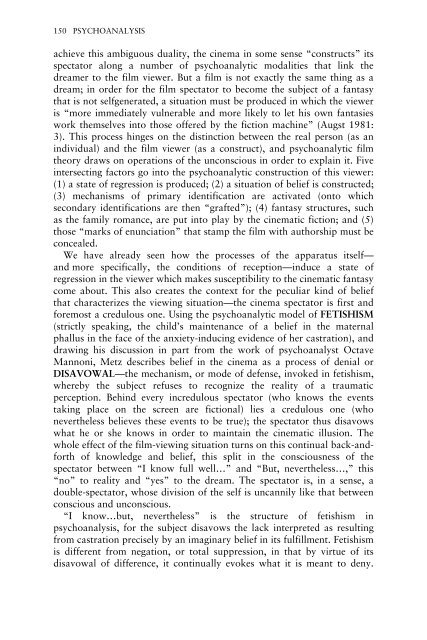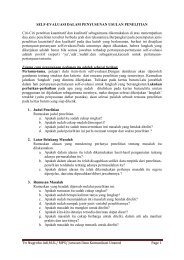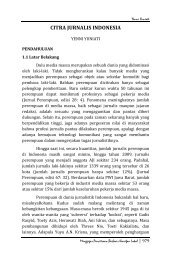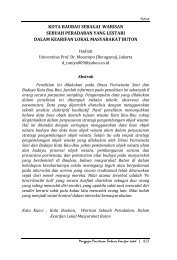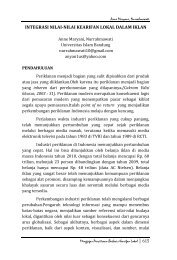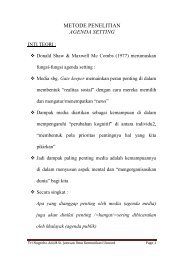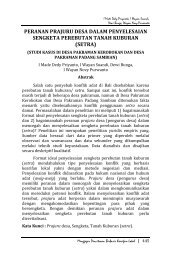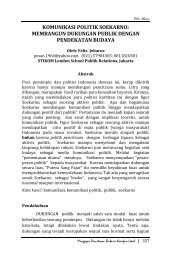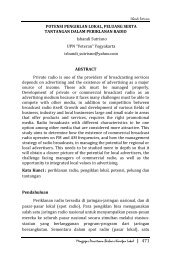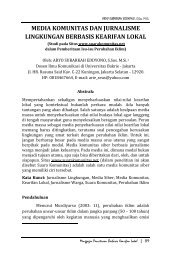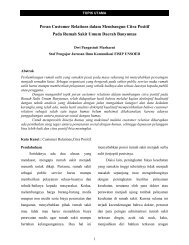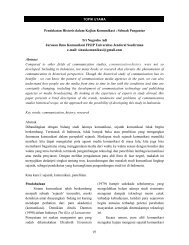New Vocabularies in Film Semiotics
New Vocabularies in Film Semiotics
New Vocabularies in Film Semiotics
Create successful ePaper yourself
Turn your PDF publications into a flip-book with our unique Google optimized e-Paper software.
150 PSYCHOANALYSIS<br />
achieve this ambiguous duality, the c<strong>in</strong>ema <strong>in</strong> some sense “constructs” its<br />
spectator along a number of psychoanalytic modalities that l<strong>in</strong>k the<br />
dreamer to the film viewer. But a film is not exactly the same th<strong>in</strong>g as a<br />
dream; <strong>in</strong> order for the film spectator to become the subject of a fantasy<br />
that is not selfgenerated, a situation must be produced <strong>in</strong> which the viewer<br />
is “more immediately vulnerable and more likely to let his own fantasies<br />
work themselves <strong>in</strong>to those offered by the fiction mach<strong>in</strong>e” (Augst 1981:<br />
3). This process h<strong>in</strong>ges on the dist<strong>in</strong>ction between the real person (as an<br />
<strong>in</strong>dividual) and the film viewer (as a construct), and psychoanalytic film<br />
theory draws on operations of the unconscious <strong>in</strong> order to expla<strong>in</strong> it. Five<br />
<strong>in</strong>tersect<strong>in</strong>g factors go <strong>in</strong>to the psychoanalytic construction of this viewer:<br />
(1) a state of regression is produced; (2) a situation of belief is constructed;<br />
(3) mechanisms of primary identification are activated (onto which<br />
secondary identifications are then “grafted”); (4) fantasy structures, such<br />
as the family romance, are put <strong>in</strong>to play by the c<strong>in</strong>ematic fiction; and (5)<br />
those “marks of enunciation” that stamp the film with authorship must be<br />
concealed.<br />
We have already seen how the processes of the apparatus itself—<br />
and more specifically, the conditions of reception—<strong>in</strong>duce a state of<br />
regression <strong>in</strong> the viewer which makes susceptibility to the c<strong>in</strong>ematic fantasy<br />
come about. This also creates the context for the peculiar k<strong>in</strong>d of belief<br />
that characterizes the view<strong>in</strong>g situation—the c<strong>in</strong>ema spectator is first and<br />
foremost a credulous one. Us<strong>in</strong>g the psychoanalytic model of FETISHISM<br />
(strictly speak<strong>in</strong>g, the child’s ma<strong>in</strong>tenance of a belief <strong>in</strong> the maternal<br />
phallus <strong>in</strong> the face of the anxiety-<strong>in</strong>duc<strong>in</strong>g evidence of her castration), and<br />
draw<strong>in</strong>g his discussion <strong>in</strong> part from the work of psychoanalyst Octave<br />
Mannoni, Metz describes belief <strong>in</strong> the c<strong>in</strong>ema as a process of denial or<br />
DISAVOWAL—the mechanism, or mode of defense, <strong>in</strong>voked <strong>in</strong> fetishism,<br />
whereby the subject refuses to recognize the reality of a traumatic<br />
perception. Beh<strong>in</strong>d every <strong>in</strong>credulous spectator (who knows the events<br />
tak<strong>in</strong>g place on the screen are fictional) lies a credulous one (who<br />
nevertheless believes these events to be true); the spectator thus disavows<br />
what he or she knows <strong>in</strong> order to ma<strong>in</strong>ta<strong>in</strong> the c<strong>in</strong>ematic illusion. The<br />
whole effect of the film-view<strong>in</strong>g situation turns on this cont<strong>in</strong>ual back-andforth<br />
of knowledge and belief, this split <strong>in</strong> the consciousness of the<br />
spectator between “I know full well…” and “But, nevertheless…,” this<br />
“no” to reality and “yes” to the dream. The spectator is, <strong>in</strong> a sense, a<br />
double-spectator, whose division of the self is uncannily like that between<br />
conscious and unconscious.<br />
“I know…but, nevertheless” is the structure of fetishism <strong>in</strong><br />
psychoanalysis, for the subject disavows the lack <strong>in</strong>terpreted as result<strong>in</strong>g<br />
from castration precisely by an imag<strong>in</strong>ary belief <strong>in</strong> its fulfillment. Fetishism<br />
is different from negation, or total suppression, <strong>in</strong> that by virtue of its<br />
disavowal of difference, it cont<strong>in</strong>ually evokes what it is meant to deny.


